

Open science: resources for sharing and publishing citizen science research - SciStarter Blog at SciStarter Blog. Science endeavors to be a collaborative and open process.
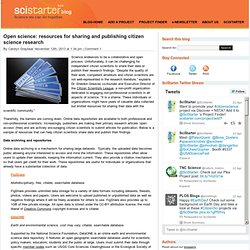
Unfortunately, it can be challenging for independent citizen scientists to share their data or publish their research findings. “Despite the quality of their work, competent amateurs and citizen scientists are not well-represented in the research literature,” explains Dr. Sheldon Greaves co-founder and Executive Director of the Citizen Scientists League, a non-profit organization dedicated to engaging non-professional scientists in all aspects of science. “It is a shame. These individuals or organizations might have years of valuable data collected but limited resources for sharing their data with the scientific community.” Thankfully, the barriers are coming down. Data archiving and repositories Online data archiving is a mechanism for sharing large datasets. FigShare Multidisciplinary, free, citable, searchable database. DataONE Earth and environmental science, cost may vary, citable, searchable database.
Dryad Scientific Data Dr. Science Citizen. Open Science. Science Online London 2011 - Keynote, Michael Nielsen. Neanderthal sex debate highlights benefits of pre-publication. An argument over sex that has been going on for more than a year is finally seeing the light of day.

Today, scientists at the University of Cambridge, UK, and Harvard Medical School in Boston, Massachusetts, let the world in on a long-running discussion over whether or not humans and Neanderthals really interbred — and how you go about proving it. I’ll get to the sex. But this debate underscores a topic I wrote about last month (see ‘Geneticists eye the potential of ArXiv‘) that noted that high-profile papers from population geneticists are beginning to appear on the preprint server, once the domain just of theoretical physicists. That story is relevant because a new paper, entitled ‘The date of interbreeding between Neandertals and modern humans’, was posted to ArXiv on Friday.
Meanwhile, a second paper raising doubts about human-Neanderthal hanky-panky appears in the Proceedings of the National Academy of Sciences (PNAS) today. Fair enough, one might say, this is how science works. FastFig. Data Science Central. We are almost there! Sorry for the long silence since my last post – we’ve been busy getting everything ready!
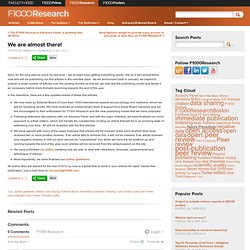
We’re in fact almost there now and will be publishing our first articles in the next few days. As we announced back in January, we expect to publish a small number of articles over the coming months so that we can fully test the publishing model and tweak it as necessary before more formally launching towards the end of the year. In the meantime, here are a few updates ahead of these first articles: We now have an Editorial Board of more than 1000 international experts across biology and medicine, which we will be revealing shortly. All author fees are waived for the rest of 2012 so now is a great time to send in your articles for rapid, hassle-free publication; just e-mail them to research@f1000.com.
Zooniverse - Real Science Online. Opening Session of the 2010 Open Science Summit. Bio Jason Hoyt Jason Hoyt is Vice-President, Research & Development and Chief Scientist at Mendeley.
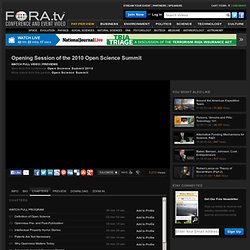
He holds a PhD in Genetics from Stanford University where he was awarded the Ruth L. Kirschstein NIH predoctoral fellowship from 2002-2007. Open Science Summit. Open-source human genomes. Open Science Summit 2011. The 1000 Genomes Project: data management and community access : Nature Methods. High-throughput sequencing technologies, including those from Illumina, Roche Diagnostics (454) and Life Technologies (SOLiD), enable whole-genome sequencing at an unprecedented scale and at dramatically reduced costs over the gel capillary technology used in the human genome project.
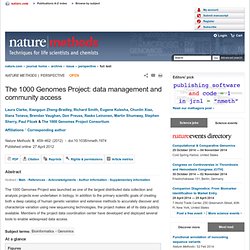
These technologies were at the heart of the decision in 2007 to launch the 1000 Genomes Project, an effort to comprehensively characterize human variation in multiple populations. In the pilot phase of the project, the data helped create an extensive population-scale view of human genetic variation1. The larger data volumes and shorter read lengths of high-throughput sequencing technologies created substantial new requirements for bioinformatics, analysis and data-distribution methods.
The initial plan for the 1000 Genomes Project was to collect 2× whole genome coverage for 1,000 individuals, representing ~6 giga–base pairs of sequence per individual and ~6 tera–base pairs (Tbp) of sequence in total. Open science is a research accelerator : Nature Chemistry. In 2006 a website (on The Synaptic Leap forum) was started in which the problem of the production of PZQ as a single enantiomer was laid out7.

There was some initial traffic, but there was little substantial community input. It is a fallacy that open-source products simply emerge — there are usually kernels of activity arising from funded work, to which the community then responds8. The OpenScience Project. Open Science Directory - Home. The Future of Science. Editor’s note: This guest post was written by Richard Price, founder and CEO of Academia.edu — a site that serves as a platform for academics to share their research papers and to interact with each other.
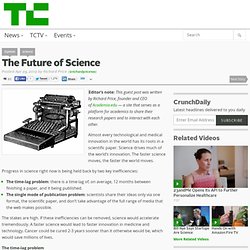
Almost every technological and medical innovation in the world has its roots in a scientific paper. Science drives much of the world’s innovation. The faster science moves, the faster the world moves. Open Science and Crowd Science: Selected Sites and Resources. Open Science and Crowd Science: Selected Sites and Resources Diane (DeDe) Dawson Natural Sciences Liaison Librarian University of Saskatchewan Saskatoon, Saskatchewan, Canadadiane.dawson@usask.ca Copyright 2012, Diane (DeDe) Dawson.

Used with permission. Soapbox Science: Tool Tales: figshare & Open Science – Making Your Impact Remain. Science Online New York (SoNYC) encourages audience participation in the discussion of how science is carried out and communicated online.

To celebrate our first birthday, we are handing the mic over to the audience so that anyone who would like to participate will get five minutes to show off their favourite online tool, application or website that makes science online fun. GitHub for Biology: Build or Buy. When I describe Synapse, the software platform we are building at Sage Bionetworks, I use the analogy “It’s like GitHub for biologists” or “GitHub for data science” a lot.
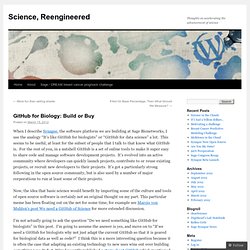
This seems to be useful, at least for the subset of people that I talk to that know what GitHub is. For the rest of you, in a nutshell GitHub is a set of online tools to make it super easy to share code and manage software development projects. It’s evolved into an active community where developers can quickly launch projects, contribute to or reuse existing projects, or recruit new developers to their projects. It’s got a particularly strong following in the open source community, but is also used by a number of major corporations to run at least some of their projects. Now, the idea that basic science would benefit by importing some of the culture and tools of open source software is certainly not an original thought on my part. 1. 2. 3. Tibidy Health: All about RNA-inhibitor. T... Evolution of Science: Open Science and the Future of Publishing. Open science. Science et curation : nouvelle pratique du Web 2.0.
Slideshare. Is the Open Science Revolution For Real? ‘Open Science’ Challenges Journal Tradition With Web Collaboration. For centuries, this is how science has operated — through research done in private, then submitted to science and medical journals to be reviewed by peers and published for the benefit of other researchers and the public at large. But to many scientists, the longevity of that process is nothing to celebrate. The system is hidebound, expensive and elitist, they say.
Peer review can take months, journal subscriptions can be prohibitively costly, and a handful of gatekeepers limit the flow of information. It is an ideal system for sharing knowledge, said the quantum physicist Michael Nielsen, only “if you’re stuck with 17th-century technology.” Dr. TEDxWaterloo - Michael Nielsen - Open Science. The Open Science Movement - KQED QUEST. Citizen scientists solved the structure of a viral protein that had been stumping scientists for a decade using the video game Foldit.
As I have talked about previously, science is a pretty closed system. Scientists do all the work pretty much in secrecy until they are ready to present a polished story. They then present their results to each other in a language only they can understand. Everyone else then has to count on the media to provide updates on what scientists have discovered. Now don’t get me wrong, the system works very well. Science in the Open. Open Science Grid Home page.